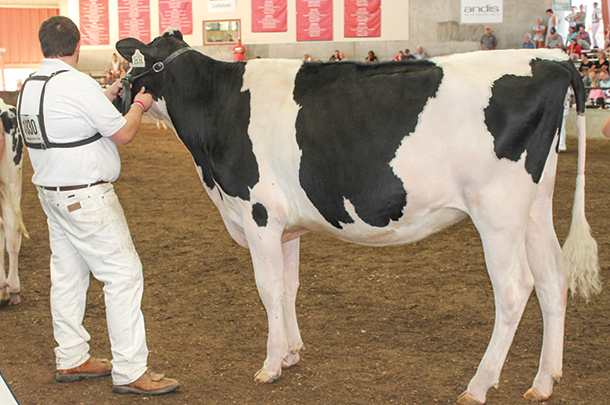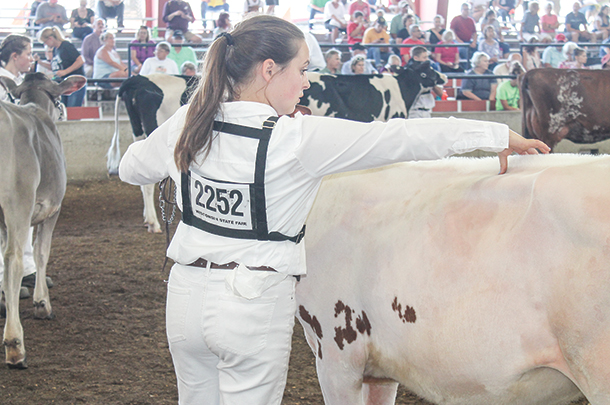County fair season may be coming to an end, but those youth looking forward to exhibiting their dairy projects at the next level are just gearing up for national shows this fall.
As you prepare for stiffer competition, take note of these five tips to sort you to the top in a showmanship class:
1. This is a set up. We’ve all learned the basic practice that, when showing a heifer, the hind leg toward the judge is back, and when showing a cow, the hind leg is forward. Front feet are close to square. So how do we go about getting the very best pose out of our heifer or cow?
- Anticipate what the judge is going to ask you to do. You know once all the cattle are in the ring and you are walking backward, the judge is going to ask you to stop and set your animal up. Be ready for this request by paying close attention to both how your animal is walking and where the judge is. When asked to stop, you may place your right hand on the heifer’s shoulder and apply the necessary pressure to make her stop and set up correctly.
- Make sure the rear legs are in place before working with the front legs. Too often, I see youth touching front feet and trying to move a front foot before the hind legs are correct. There is no way to get the front right before the back feet are placed properly.
- Just because the rear leg toward the judge is back does not mean your heifer is set up. The rear legs must be placed squarely underneath to her very best advantage. Make sure the legs are not too stretchy or too close together.
- Once the rear legs are set, move the front feet so they are square. This can be accomplished in two ways. One method is to simply pull or push back with a very small amount of pressure on the halter. You want her to shift her weight, not take a step, so the movement should be gentle.
- Another way to move front feet is to very discreetly use your foot to make the heifer move. To accomplish this, step in to the shoulder of your heifer while keeping her head straight in line with her body.
If moving the foot slightly ahead, keep a forward pressure on the halter and touch the foot under the dewclaw. This will make your heifer pick up her foot and move it forward. If moving the foot back, apply back pressure on the halter and touch the foot right above the hoof line. However, never kick the foot.
The very best way to have your heifer set up correctly in the show ring is to practice at home. Ideally, your showmanship animal should walk right into the correct position every time.
2. This is my dance space. Showing cattle is not about you (the leadsperson), it’s about your animal. When leading, a judge should not see your head or upper body behind your heifer or cow. Especially when leading a calf smaller than you are, you should be well out in front of the calf and not leading from the shoulder area of the animal.

The very best position to be in at all times is in front of the nose of your heifer. This gives you the best control and does not break up the silhouette of the heifer. The key word is “leading” – you can’t lead a heifer if your body is positioned behind her head and shoulder. Just as if you were dancing, stay in your space.
3. Straight ahead. Several years ago, a bad habit developed in the show ring with leadsmen pulling the animals’ noses toward themselves. This makes the animal’s neck appear shorter, thus she appears shorter from end to end, and it gives her the opportunity to get in front of you; you risk losing control.
Always keep the head straight in line with her body so, if you could look from the back of your heifer, you would see a perfectly straight line from her tailhead to her nose. When stopped to set your animal up, extra points to you if you can tip her nose slightly in toward the center of the ring, similar to professional pictures of show cattle.
4. Don’t move. We’ve talked about standing in line in past articles but, since it is important, we want to fine-tune the advice.

- When showing a heifer:
1.For the two heifers on either end of the line, the outside leg is back. There is a reason for this. When the leg toward the judge is back, your heifer will look longer.
2.If you are not in first or last, you should pull in and set the heifer up in a balanced stance so she looks her very best. Once in line, you do not need to move your heifer back and forth as the judge goes from side to side.
3.If your heifer does not look her best, get her in the best position possible. Don’t settle for “good enough.” This will lose you placings both in showmanship and in type classes.
- When showing a cow, you will need to move her legs as the judge moves from side to side. The reason for this is: You want the fore udder to look balanced and the rear udder to be visible.
- If you are in a large class, and your heifer starts to relax, back her up a few steps and bring her back together. You can do this when the judge is evaluating someone away from where you are in line.
5. Obey the “five-by-five” rule. Always keep 5 feet in front of you and stay 5 feet from the edge of the ring. Here’s why:
- The judge must have room to evaluate your heifer from both sides. If you are too close to the edge of the ring, or the heifer in front of you, he can’t get around her.
- It is much safer. Picture your grandparents or the stroller that is always on the side of the ring. You do not want to put yourself, your animal or anyone else at risk of injury.
- Your heifer looks better away from the wall.
- By leaving 5 feet in front of you, there is room to set the heifer up or to compensate for someone following too closely behind.
- Finally, it’s your responsibility to know where everyone around you is at all times. If you run into the person ahead of you, and spook their animal, that is your fault, and you’ll be penalized for it in class.
Remember the three goals of showmanship: Make your animal look her best at all times, know the rules, and have fun. When you are confident you have done your best, you will surely have fun, regardless of the outcome. We’ll see you at a fall show.
PHOTO 1: This young lady has everything in place and is keenly watching the judge. Her halter is snug under the heifer’s chin, with the halter wrapped in a neat circle to give a clean-cut appearance when viewed from the other side. She is properly positioned in front of the nose of her heifer.
PHOTO 2: This young man has his heifer set up in a very balanced position with her front feet square and back feet correctly placed underneath her.
PHOTO 3: This young exhibitor is dressed properly with a long-sleeved white shirt, belt and harness that fits properly, her hair pulled back in a neat ponytail. She has stepped into her calf and is touching her animal down to correct a fault in her calf. Photos provided by Katie Coyne.
Katie Coyne is a dairy youth consultant. Email Katie Coyne.




